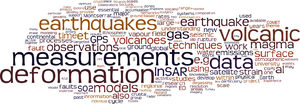NCEO:Theme 6: Difference between revisions
No edit summary |
|||
| Line 18: | Line 18: | ||
==National Centre for Earth Observation: Theme 6== | ==National Centre for Earth Observation: Theme 6== | ||
[http://comet.nerc.ac.uk/ '''NCEO: Theme 6''' (COMET+)] is a component of the National Centre for Earth Observation funded by [[NERC]]. The theme developed from the '''C'''entre for the '''O'''bservation and '''M'''odelling of '''E'''arthquakes and '''T'''ectonics (COMET) consortium. NCEO:Theme 6 or COMET+ is occasioanlly refered to as the DEATH theme which is a back formation acronym of '''D'''ynamic '''E'''arth '''A'''nd '''T'''errestrial '''H'''azards. | [http://comet.nerc.ac.uk/ '''NCEO: Theme 6''' (COMET+)] is a component of the National Centre for Earth Observation funded by [[NERC]].<ref|group="F"> The theme developed from the '''C'''entre for the '''O'''bservation and '''M'''odelling of '''E'''arthquakes and '''T'''ectonics (COMET) consortium. NCEO:Theme 6 or COMET+ is occasioanlly refered to as the DEATH theme which is a back formation acronym of '''D'''ynamic '''E'''arth '''A'''nd '''T'''errestrial '''H'''azards.</ref> | ||
EODG's contribution to COMET+ is to use EO data to measure global and regional budgets of volcanic | EODG's contribution to COMET+ is to use EO data to measure global and regional budgets of volcanic | ||
| Line 40: | Line 40: | ||
the crust, and upon the local stress regime. We plan observations on a hierarchy of scales from the | the crust, and upon the local stress regime. We plan observations on a hierarchy of scales from the | ||
global to the regional down to the individual volcano, to address different aspects of volcanic systems. | global to the regional down to the individual volcano, to address different aspects of volcanic systems. | ||
===Footnotes=== | |||
<Reflist|group="F"> | |||
==Publications== | ==Publications== | ||
Revision as of 22:45, 15 December 2012
National Centre for Earth Observation: Theme 6
NCEO: Theme 6 (COMET+) is a component of the National Centre for Earth Observation funded by NERC.<ref|group="F"> The theme developed from the Centre for the Observation and Modelling of Earthquakes and Tectonics (COMET) consortium. NCEO:Theme 6 or COMET+ is occasioanlly refered to as the DEATH theme which is a back formation acronym of Dynamic Earth And Terrestrial Hazards.</ref>
EODG's contribution to COMET+ is to use EO data to measure global and regional budgets of volcanic emissions, particularly of SO2. Working with our collaborators we will integrate these measurements with regional- to local-scale measurements of volcanic emissions, ground deformation, and seismicity, to improve mathematical models for the mechanics of volcanic systems.
Volcanic SO2 is a key gas species for the planet’s radiative balance and atmospheric composition (Graf et al., 1997; Robock, 2000; Grainger and Highwood, 2003; Millard et al., 2006), and, in combination with other species, for understanding magmatic processes. Volcanic SO2 is also a significant component of the stratospheric sulphur budget (Pyle et al., 1996), however volcanic SO2 release to the atmosphere is both uncertain and variable (7–11 Tg S yr-1, Mather et al., 2003) and individual volcanic emissions can cause large local and regional perturbations. Recent developments in satellite-borne remote sensing of volcanic gases and particles allow us, for the first time, to detect and measure volcanic emissions on a global scale in near-real time. These advances will enable us to investigate the controls on these fluxes, and to understand their consequences for the Earth’s surface and atmosphere.
The processes of magma ascent and eruption depend strongly upon the evolution of the magma’s physical properties as it partitions into melt, crystals and gas during ascent, upon the mechanical interactions between magma and its surrounding rock, which determine the magma’s pathways through the crust, and upon the local stress regime. We plan observations on a hierarchy of scales from the global to the regional down to the individual volcano, to address different aspects of volcanic systems.
Footnotes
<Reflist|group="F">
